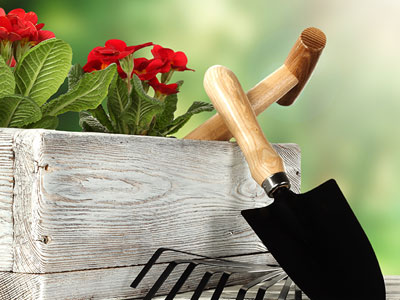Monthly Gardening Advice – May

MAY
Lawncare
- Mow the lawn weekly and remember to add the clippings to your compost heap.
- Continue to apply a high nitrogen liquid fertiliser to keep the lawn looking healthy.
- Edge the lawn to create a ‘gutter’ around the lawn edge (this stops the lawn from growing into the border).
- Ensure new lawns from seed or turf do not dry out.
- If you have a problem with moss and weeds apply a combined moss and weed killer.
Houseplant Care
- Increase the watering and begin liquid feeding.
- Clean shiny leaved plants with a damp cloth and spiky plants with a soft brush.
- Make sure houseplants get plenty of fresh air.
- Move plants like citrus and cymbidiums outside on warm days and bring in if a chilly night is forecast.
- Apply shade paint to the outside of the greenhouse glass or use blinds on sunny days to prevent temperatures soaring.
Jobs To Do In The Garden
- Plant out summer bedding at the end of the month once frosts have cleared.
- Hoe borders and beds to stop weed growth.
- Divide cottage garden plants such as hosta and primrose.
- Lift and divide overcrowded bulbs like daffodils.
- Mulch around shrubs, roses and trees to help prevent moisture loss and suppress weeds.
- Thin out outdoor sown hardy annuals.
- Prune spring flowering shrubs once they have finished flowering (forsythia, spiraea, berberis and ribes)
- Sweet peas can be trained onto their supports to create a good display.
- Continue to plant container grown plants.
- Dead-head pansies, violas and primulas.
- Put supports in place for your cottage garden plants before they get too big.
- Clip evergreen hedges if not too woody, shredded clippings can be added to compost heap (remember to check for nesting birds).
- Tie in climbers.
- Make sure tubs, hanging baskets and troughs are well watered. Use collected rainwater, or recycled grey water whenever possible.
- Check for first signs of blackspot, aphid and rolling sawfly on roses and treat with a suitable pest and disease control.
Jobs To Do In The Greenhouse
- Keep the temperature in the greenhouse at 5°C for fuchsia and geraniums and a warmer 12°C for topical plants.
- Remember to ventilate greenhouse on sunny days and on the warmest days you may need to damp the floor down to increase the humidity.
- Check seedlings for damping off, which can be a problem under glass (if it becomes a problem treat with ‘Cheshunt Compound).
- Give plants more space as they grow to help avoid pest infestations.
- Soft tip Fuchsia cuttings can be taken this month.
- Greenhouse bulbs that have finished flowering can be given a high potash feed (Tomorite) to help build the bulb up for next season.
- Warm up cold grow-bags before planting tomatoes, cucumbers and peppers by putting then in-situ.
- Harden off half-hardy annuals, which have been started undercover and need acclimatise to the outside environment over a period of a week or so ready for planting in their final position.
- Used shade paint on outside of greenhouse or blinds to stop temperatures soaring.
The Vegetable Garden
- Earth up potatoes and promptly plant any still remaining.
- Once the risk of frost has gone plant out tomatoes, courgettes and pumpkins, which have been grown undercover, they will need to acclimatise to the cooler outdoor environment.
- Liquid feed plants regularly that grow in containers.
- Net fruit and vegetable plants to keep birds off.
- Sow melons in a heated propagator.
- Protect brassicas from pigeons.
- Put up codling moth traps.
- Protect carrots with enviromesh to stop damage from carrot root fly
- Make sure bees have access to flowers in cloches and cages for pollination.
- Continue to prepare seedbeds and cover with fleece or polythene to warm the soil before planting.
- Continue to harvest asparagus, spring onions, spring cabbage, radishes, salad leaves, spring cauliflower and leeks.
- Protect flowers from possible late frosts.
- Keep on top of weed control to help stop the spread of pest and disease.
- Thin raspberry, gooseberries plants and de-blossom strawberry runners planted in spring.
Wildlife & Bird Care
- Put up nesting boxes for migrant birds arriving in the UK.
- Put up bat nesting boxes.
- Keep birdbaths topped up with water.
- Mow recently established perennial meadows but not annual cornfield meadows.
- Put out log and/ or rock piles to create areas of shelter for wildlife
- Avoid chunky foods that could choke young fledglings.
- Hang a bee-nesting box.
- Sow or plant a wildflower meadow.
- Make sure you pond is more wildlife friendly (by planting around the pond and creating a shallow edge so wildlife can access the pond safely).
- Leave informal hedges untrimmed for a while to provide food and shelter.
Any Other Advice
- Collect grey water for watering containers and baskets.
- If the weather warms up you may need to raise the cutting height on the lawn mower.
- Remember to support your perennial plants to stop them flopping over later in the summer
- In dry spell treat timber structures and buildings (remembering to use in a well ventilated space and use an appropriate product).
Enjoy your garden and don’t forget to take time and stop and stare at the wonder of nature. Happy gardening!
